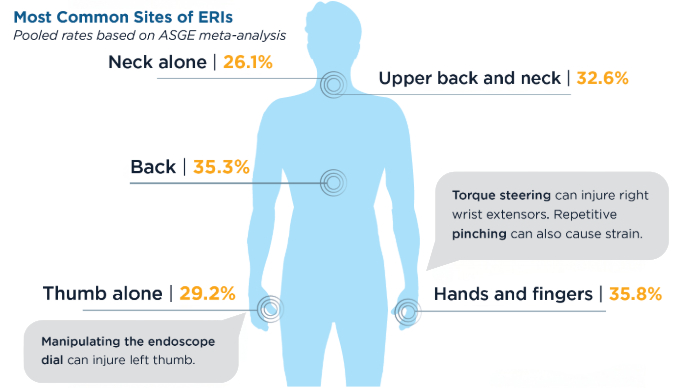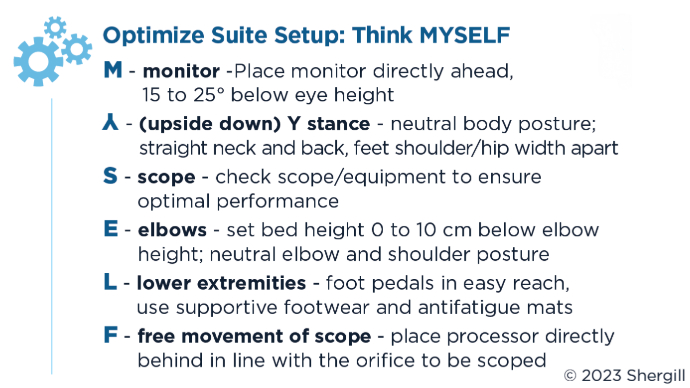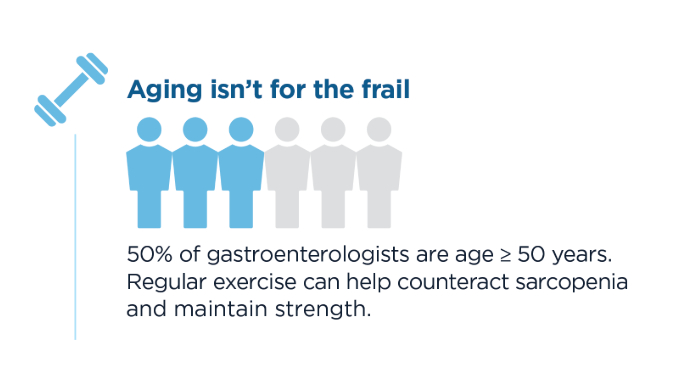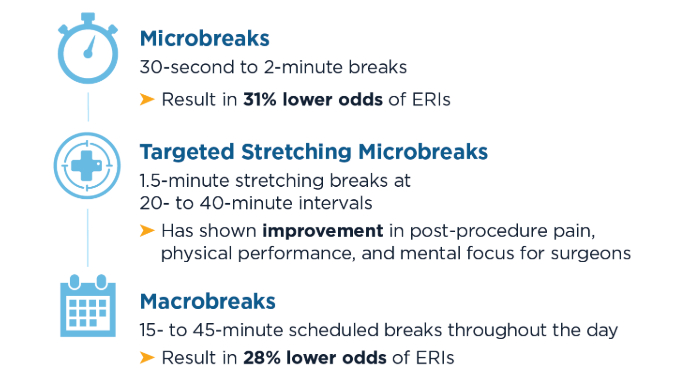Ergonomics in Endoscopy





Amandeep K. Shergill, MD, MS
Professor of Clinical Medicine, Division of Gastroenterology
University of California
San Francisco, California
Amandeep K. Shergill, MD, MS, reported the following relevant financial disclosures: Serve(d) as a director, officer, partner, employee, advisor, consultant, or trustee for: Boston Scientific; Neptune Medical; Dragonfly Endoscopy; UpToDate; Serve(d) as a speaker or a member of a speakers bureau for: Pentax Medical EMEA; Received income in an amount equal to or greater than $250 from: Neptune; Dragonfly Endoscopy; Pentax EMEA; UpToDate





Endoscopy is a major component of the work of gastroenterologists, with 61% of gastroenterologists reporting spending more than 40% of their time performing endoscopic procedures.1 Endoscopists are particularly prone to sustaining musculoskeletal injuries in their practice, given that current scopes were not designed to accommodate the range of physician hand sizes and strength.2 In addition, the 2023 American Society for Gastrointestinal Endoscopy (ASGE) guidelines note that the endoscopy volume of the current-day endoscopist makes this a physically taxing career for many operators.3
The ASGE systematic review and meta-analysis found an overall endoscopy-related injury (ERI) rate of 57.7%, with survey results ranging from 39% to 89%.3 These injuries, in some cases, start during fellowship, with 1 in 5 gastrointestinal fellows developing endoscopy-related pain and/or injuries.4 Musculoskeletal injuries can occur as result of microtrauma caused by the repetitive motions, prolonged awkward postures, and sustained high pinch force used during endoscopy.5 Additional risk factors for injury include higher procedure volume (> 20 cases per week), more time spent doing endoscopy per week (> 16 hours per week), and cumulative years performing endoscopy.3
 Overview of Endoscopy-Related Injuries3,5
Overview of Endoscopy-Related Injuries3,5
ERIs are musculoskeletal injuries caused by repetitive microtrauma to muscles, tendons and nerves. Biomechanical forces that contribute to ERIs include repetitive, high-force loads in non-neutral postures. The overall rate of ERIs in female endoscopists is 62.4% compared with 45.5% in male endoscopists. Avoiding the Hazards of Endoscopy: Ergonomics as a Guide6,8
Avoiding the Hazards of Endoscopy: Ergonomics as a Guide6,8
Preventing disability and facilitating a long and successful endoscopic career involves taking proactive measures that enhance well-being, and ergonomics plays a significant role. Avoiding the Hazards of Endoscopy: Ergonomics as a Guide6,8
Avoiding the Hazards of Endoscopy: Ergonomics as a Guide6,8 Avoiding the Hazards of Endoscopy: Ergonomics as a Guide6,8
Avoiding the Hazards of Endoscopy: Ergonomics as a Guide6,8 Avoiding the Hazards of Endoscopy: Ergonomics as a Guide6,8
Avoiding the Hazards of Endoscopy: Ergonomics as a Guide6,8 Avoiding the Hazards of Endoscopy: Ergonomics as a Guide6,8
Avoiding the Hazards of Endoscopy: Ergonomics as a Guide6,8 Avoiding the Hazards of Endoscopy: Ergonomics as a Guide6,8
Avoiding the Hazards of Endoscopy: Ergonomics as a Guide6,8 Microbreaks and Macrobreaks3
Microbreaks and Macrobreaks3
Incorporating ergonomic breaks into endoscopy practice can significantly reduce the risk for injuries. Evidence supports the use of microbreaks, targeted stretching, and scheduled macrobreaks to reduce the risk for ERIs, alleviate pain, enhance focus, and improve physical performance for endoscopists. Overview of Endoscopy-Related Injuries3,5
Overview of Endoscopy-Related Injuries3,5
ERIs are musculoskeletal injuries caused by repetitive microtrauma to muscles, tendons and nerves. Biomechanical forces that contribute to ERIs include repetitive, high-force loads in non-neutral postures. The overall rate of ERIs in female endoscopists is 62.4% compared with 45.5% in male endoscopists. Avoiding the Hazards of Endoscopy: Ergonomics as a Guide6,8
Avoiding the Hazards of Endoscopy: Ergonomics as a Guide6,8
Preventing disability and facilitating a long and successful endoscopic career involves taking proactive measures that enhance well-being, and ergonomics plays a significant role. Avoiding the Hazards of Endoscopy: Ergonomics as a Guide6,8
Avoiding the Hazards of Endoscopy: Ergonomics as a Guide6,8 Avoiding the Hazards of Endoscopy: Ergonomics as a Guide6,8
Avoiding the Hazards of Endoscopy: Ergonomics as a Guide6,8 Avoiding the Hazards of Endoscopy: Ergonomics as a Guide6,8
Avoiding the Hazards of Endoscopy: Ergonomics as a Guide6,8 Avoiding the Hazards of Endoscopy: Ergonomics as a Guide6,8
Avoiding the Hazards of Endoscopy: Ergonomics as a Guide6,8 Avoiding the Hazards of Endoscopy: Ergonomics as a Guide6,8
Avoiding the Hazards of Endoscopy: Ergonomics as a Guide6,8 Microbreaks and Macrobreaks3
Microbreaks and Macrobreaks3
Incorporating ergonomic breaks into endoscopy practice can significantly reduce the risk for injuries. Evidence supports the use of microbreaks, targeted stretching, and scheduled macrobreaks to reduce the risk for ERIs, alleviate pain, enhance focus, and improve physical performance for endoscopists. Overview of Endoscopy-Related Injuries3,5
Overview of Endoscopy-Related Injuries3,5
ERIs are musculoskeletal injuries caused by repetitive microtrauma to muscles, tendons and nerves. Biomechanical forces that contribute to ERIs include repetitive, high-force loads in non-neutral postures. The overall rate of ERIs in female endoscopists is 62.4% compared with 45.5% in male endoscopists. Avoiding the Hazards of Endoscopy: Ergonomics as a Guide6,8
Avoiding the Hazards of Endoscopy: Ergonomics as a Guide6,8
Preventing disability and facilitating a long and successful endoscopic career involves taking proactive measures that enhance well-being, and ergonomics plays a significant role. Avoiding the Hazards of Endoscopy: Ergonomics as a Guide6,8
Avoiding the Hazards of Endoscopy: Ergonomics as a Guide6,8 Avoiding the Hazards of Endoscopy: Ergonomics as a Guide6,8
Avoiding the Hazards of Endoscopy: Ergonomics as a Guide6,8 Avoiding the Hazards of Endoscopy: Ergonomics as a Guide6,8
Avoiding the Hazards of Endoscopy: Ergonomics as a Guide6,8 Avoiding the Hazards of Endoscopy: Ergonomics as a Guide6,8
Avoiding the Hazards of Endoscopy: Ergonomics as a Guide6,8 Avoiding the Hazards of Endoscopy: Ergonomics as a Guide6,8
Avoiding the Hazards of Endoscopy: Ergonomics as a Guide6,8 Microbreaks and Macrobreaks3
Microbreaks and Macrobreaks3
Incorporating ergonomic breaks into endoscopy practice can significantly reduce the risk for injuries. Evidence supports the use of microbreaks, targeted stretching, and scheduled macrobreaks to reduce the risk for ERIs, alleviate pain, enhance focus, and improve physical performance for endoscopists.Item 1 of 8Click to view more from Gastroenterology Data Trends 2025.
,false×ADVERTISEMENTADVERTISEMENTADVERTISEMENT

